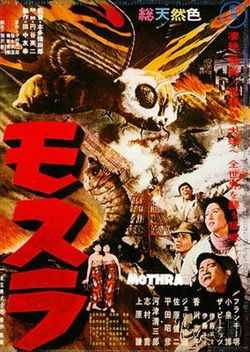Mothra
| Godzilla film series character | |
|---|---|
| Mothra | |
 | |
| Alias | Mosura |
| First appearance | Mothra (1961) |
| Latest appearance | Godzilla 2 (2018) |
| Created by | Shinichiro Nakamura, Yoshie Hotta, Takehiko Fukanaga |
Mothra (モスラ Mosura) is a kaiju who first appeared in Toho's 1961 film Mothra. Mothra has appeared in several Toho tokusatsu films, most often as a recurring character in the Godzilla franchise.[1]
Overview
Name
The name "Mothra" is the suffixation of "-ra" to the English word "moth"; since the Japanese language does not have dental fricatives, it is approximated "Mosura" in Japanese. The “ra” suffix follows the precedent set by “Gojira”, which in turn is derived from kujira (鯨(クジラ), the Japanese word for “whale,” to indicate the character’s enormous size.
Development

Mothra’s iconic character design is that of a giant brown caterpillar with blue eyes, or a colourful imago form that combines attributes of moths and butterflies along with fictional embellishments such as chewing mouthparts, ocelli and talons. It is typically depicted onscreen via puppetry; a radio controlled animatronic prop on wheels for its caterpillar form, and a marionette with overhead wires moving the wings and body as an imago. In more recent films it has been rendered with CGI as well.
At the time of its creation, Mothra’s colourful appearance and benevolent nature set Mothra apart from Toho’s other giant monster characters. Mothra is generally portrayed as a giant insect that lives on a tropical island, where it is worshipped as a deity. It is a peaceful character that only fights to protect itself, its allies, or the Earth. It is usually accompanied by miniature twin fairies, who summon it into battle by singing a prayer (Mosura No Uta). Depending on the film, the Twins have gone by many titles, such as the Shobijin, the Cosmos, and the Elias. The Rebirth of Mothra trilogy expanded on their characterization, giving the fairies names - Lora and Moll – and an evil sister named Belvera.
Mothra has been portrayed as using a number of special abilities. It has been shown to have the ability to spray silk, metamorphose, fly, generate hurricane-force wind, scatter poison, drop wings and use various magical energy attacks. According to character profiles it has been given in supporting media, Mothra measures 30[3]-180[4] meters long and weighs 9,000[3]-15,000[4] tons in its larval form, and possess a weight of 15,000[3]-25,000[4] tons and a wingspan of 75[3]-250[4] meters in its imago form. Mothra is one of Godzilla’s most frequently recurring opponents, though it has never defeated Godzilla without assistance; in some stories, Mothra is also portrayed as Godzilla’s ally.
Reception
Mothra is one of Toho’s most popular monsters, and second only to Godzilla in its total number of film appearances. Toho had intended to follow 1989's Godzilla vs. Biollante with a revival of Mothra in her own spin-off film, Mothra vs. Bagan, for 1990 release. However, following the disappointing box office performance of Biollante, Toho discarded the project in favor of another Godzilla film, Godzilla vs. King Ghidorah (1991).[5] A 1992 survey revealed that Mothra was Toho's most popular character among women, an observation which inspired Toho to again revise its plans, abandoning a proposed sequel to King Ghidorah in favor of a Godzilla/Mothra feature.[6] Following the end of the Heisei Godzilla series, Toho produced a trilogy of Mothra films, known in the U.S. as Rebirth of Mothra (1996–1998). Mothra thus became the first Toho daikaiju to lead its own film(s) after its incorporation into the Godzilla franchise.
Appearances
Films
- Mothra (film) (1961)
- Mothra vs. Godzilla (1964)
- Ghidorah the Three Headed Monster (1964)
- Godzilla vs. the Sea Monster (1966)
- Destroy All Monsters (1968)
- Godzilla vs. Mothra (1992)
- Rebirth of Mothra (1996)
- Rebirth of Mothra II (1997)
- Rebirth of Mothra III (1998)
- Godzilla, Mothra and King Ghidorah: Giant Monsters All-Out Attack (2001)
- Godzilla: Tokyo S.O.S. (2003)
- Godzilla: Final Wars (2004)
- Godzilla 2 (2018) - Legendary Pictures and Gareth Edwards, director of Godzilla, confirmed that the rights to King Ghidorah, Mothra, and Rodan from the Toho Studios films have been acquired, and that the characters may appear in "future franchise installments".[7][8]
Television
- Godzilla Island (1997-1998)
Video games
- Godzilla: Monster of Monsters (NES - 1988)
- Godzilla 2: War of the Monsters (NES - 1991)
- Kaijū-ō Godzilla / King of the Monsters, Godzilla (Game Boy - 1993)
- Godzilla: Monster War / Godzilla: Destroy All Monsters (Super Famicom - 1994)
- Godzilla Giant Monster March (Game Gear - 1995)
- Godzilla Trading Battle (PlayStation - 1998)
- Godzilla Generations: Maximum Impact (Dreamcast - 1999)
- Godzilla: Destroy All Monsters Melee (GCN, Xbox - 2002/2003)
- Godzilla: Domination! (GBA - 2002)
- Godzilla: Save the Earth (Xbox, PS2 - 2004)
- Godzilla: Unleashed (Wii - 2007)
- Godzilla Unleashed: Double Smash (NDS - 2007)
- Godzilla: Unleashed (PS2 - 2007)
- Godzilla: The Game (PS3 - 2014 PS3 PS4 - 2015)
Literature
- The Luminous Fairies and Mothra (Serialized novel)
- Godzilla: Kingdom of Monsters (Comic - 2012)
- Godzilla: Rulers of Earth (Comic - 2013)
References
- ↑ "Godzilla Vs. King Ghidorah / Godzilla And Mothra: The Battle For Earth - Set (Blu-ray)". DVD Talk. Retrieved 27 September 2014.
- ↑ "Okinawa: Which island is for you?". CNN Travel. Retrieved 27 September 2014.
- ↑ 3.0 3.1 3.2 3.3 Mothra [Millennium]
- ↑ 4.0 4.1 4.2 4.3 Mothra [Heisei]
- ↑ "Lost Project: Mothra vs. Bagan", TohoKingdom. Retrieved January 25, 2006.
- ↑ Milner, David. Interview with Koichi Kawakita, December 1994.
- ↑ Jeffries, Adrianne (July 26, 2014). "Gareth Edwards returns to direct 'Godzilla 2' with Rodan and Mothra". The Verge. Retrieved 2014-08-19.
- ↑ Sullivan, Kevin P. (2014-08-14). "‘Godzilla 2′ Gets Release Date: ‘Let Them Wait’". MTV.
| ||||||||||||||||||||||||||||||||||||||||||||||||||||||||||||||